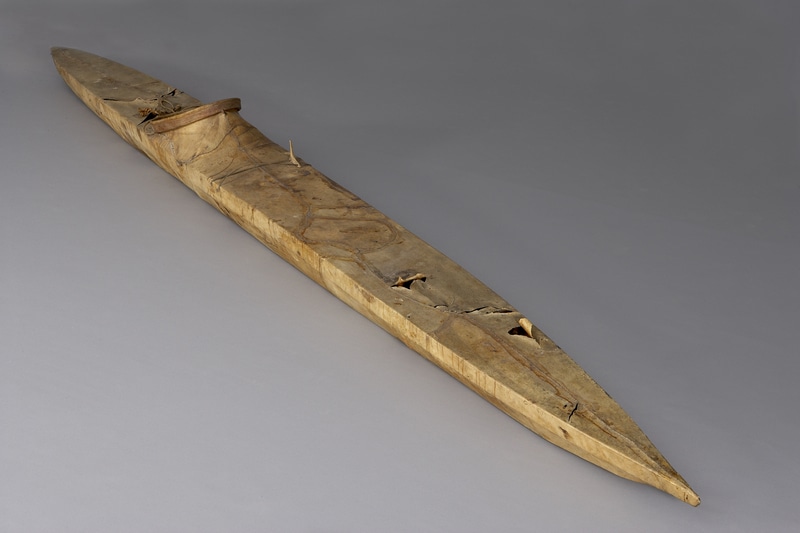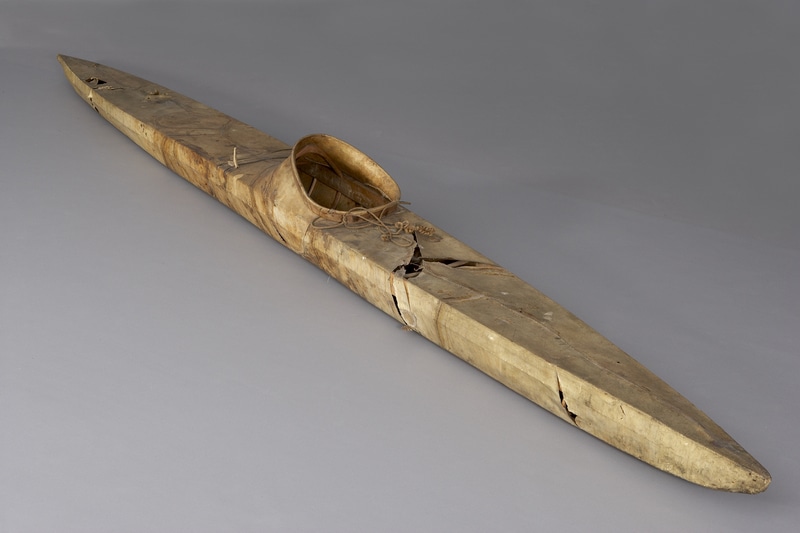Kayak Item Number: Na1145 from the MOA: University of British Columbia



Description
Skin covered kayak with a single angled cockpit; relatively flat on top and keel; rounded bow tapers to a point and raises slightly from bottom; stern also tapers to a point and is raised from bottom. Series of evenly spaced (where visible) ribs attach to gunwales; ribs are flat on bottom and curve sharply at sides. Three longitudinal keel supports and additional supports around and extending from cockpit. Numerous skins are sewn together, covering kayak; the skin is sewn to a bent wood rim at cockpit. In front of cockpit is a bone support attached to top, side of kayak by a leather thong which passes through two holes on base of the support and through two holes on either side of kayak. There is a rope attached to the back of the cockpit on both sides. The skin covering is pieced by stitching in numerous places.
History Of Use
Kayaks from the copper area are used more for hunting in inland lakes and streams, than they are used for transportation. In general, they are larger and lighter than most sea going kayaks. A double bladed paddle is used with them.
Cultural Context
hunting
Specific Techniques
After the frame of a traditional kayak is constructed, using an adze, crooked knife, drill, lashings and wooden pegs, then several wet seal skins are sewn with a waterproof stitch to cover the kayak. Several women sew quickly before the skins dry and shrink to form a taut covering.
Narrative
According to the old Museum ledger, Ian M. Mackinnon presented Frank Burnett with this collection of Inuit objects. They were collected during his three years of residence in the Coppermine River area, probably 1921-24.
Item History
- Made in Coppermine, Nunavut, Canada and Kugluktuk, Nunavut, Canada before 1925
- Collected between 1920 and 1925
- Owned by Ian M. Mackinnon
- Owned by Frank Burnett before 1927
- Received from Frank Burnett (Donor) on July 25, 1927
What
Who
- Culture
- Inuit: Inuinnait
- Previous Owner
- Ian M. Mackinnon and Frank Burnett
- Received from
- Frank Burnett (Donor)
Where
- Holding Institution
- MOA: University of British Columbia
- Made in
- Coppermine, Nunavut, Canada and Kugluktuk, Nunavut, Canada
When
- Creation Date
- before 1925
- Collection Date
- between 1920 and 1925
- Ownership Date
- before 1927
- Acquisition Date
- on July 25, 1927
Other
- Condition
- poor
- Current Location
- Case 47
- Accession Number
- 2191/0145